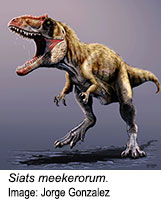- Double Mastectomy May Offer No Survival Benefit to Women With Breast Cancer
- Toxic Lead Found in Cinnamon Product, FDA Says
- Certain Abbott Blood Sugar Monitors May Give Incorrect Readings
- Athletes Can Expect High Ozone, Pollen Counts for Paris Olympics
- Fake Oxycontin Pills Widespread and Potentially Deadly: Report
- Shingles Vaccine Could Lower Dementia Risk
- Your Odds for Accidental Gun Death Rise Greatly in Certain States
- Kids From Poorer Families Less Likely to Survive Cancer
- Tough Workouts Won’t Trigger Cardiac Arrest in Folks With Long QT Syndrome
- At-Home Colon Cancer Test Can Save Lives
Colossal Predatory Dinosaur Remains Identified in Utah


Scientists have identified a giant meat-eating dinosaur that roamed the Earth about 100 million years ago and was likely dominant over early tyrannosaurs.
The remains of the creature were found in the Cedar Mountain Formation in Utah. It is the first of its kind discovered in North America, the researchers said in a news release from the Field Museum of Natural History in Chicago.
“This dinosaur was a colossal predator second only to the great T. rex and perhaps Acrocanthosaurus in the North American fossil record,” said study lead author Lindsay Zanno, director of paleontology at the North Carolina Museum of Natural Sciences and North Carolina State University.
The dinosaur — named Siats meekerorum — was more than 30 feet long and weighed more than four tons. Zanno initially discovered it in 2008 and its remains were retrieved during an excavation that lasted two summers.
The newly identified meat-eater was not a close relative of T. rex, but belongs to the family of predatory dinosaurs known as carcharodontosaurs. A famous member of that family is the Giganotosaurus, which was first discovered in Argentina.
Siats belongs to a branch of that family that was previously unknown in North America, according to the study, which was published in the Nov. 22 issue of the journal Nature Communications.
“We were thrilled to discover the first dinosaur of its kind in North America and add to mounting evidence that dinosaurs were widely dispersed across the globe 100 million years ago,” study co-author Peter Makovicky, curator of dinosaurs at the Field Museum, said in the news release.
Siats appears in the middle of a 30-million-year gap in the fossil record of large predatory dinosaurs in North America. During that time, the top predator role changed from carcharodontosaurs in the Early Cretaceous period to tyrannosaurs in the Late Cretaceous period.
Teeth of tyrannosaurs from the Utah site indicate that the tyrannosaurs that were around at the same time as Siats were much smaller and did not compete for the top predator role.
“The huge size difference certainly suggests that tyrannosaurs were held in check by carcharodontosaurs, and only evolved into enormous apex predators after the carcharodontosaurs disappeared,” Makovicky said.
“Finding Siats in the 30-million-year predator gap tells us carcharodontosaurs reigned supreme in North America for much longer than anyone had expected,” Zanno said in the news release.
More information
The Smithsonian National Museum of Natural History has more about dinosaurs.
Source: HealthDay
Copyright © 2024 HealthDay. All rights reserved.










